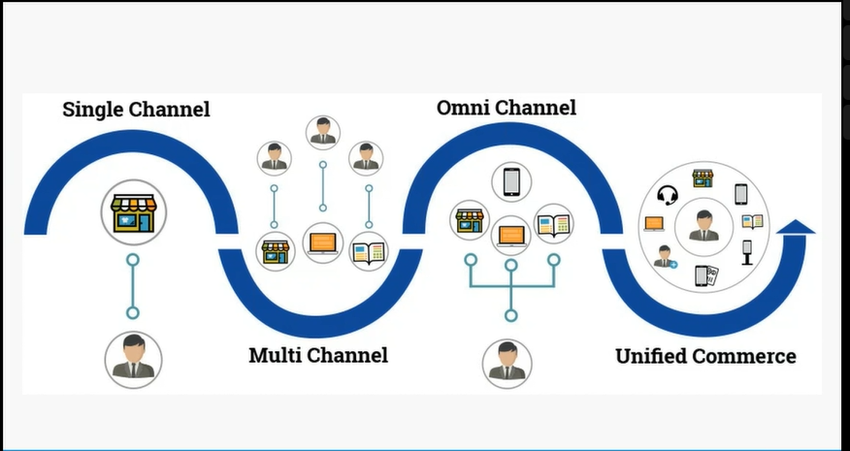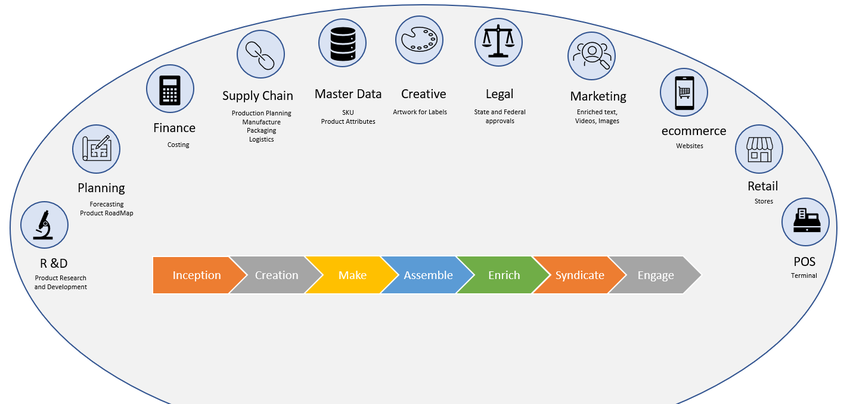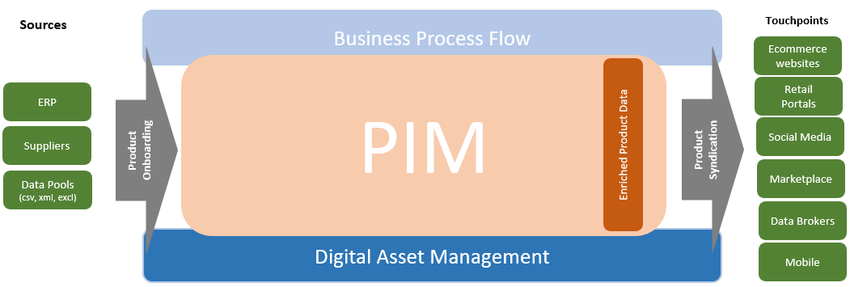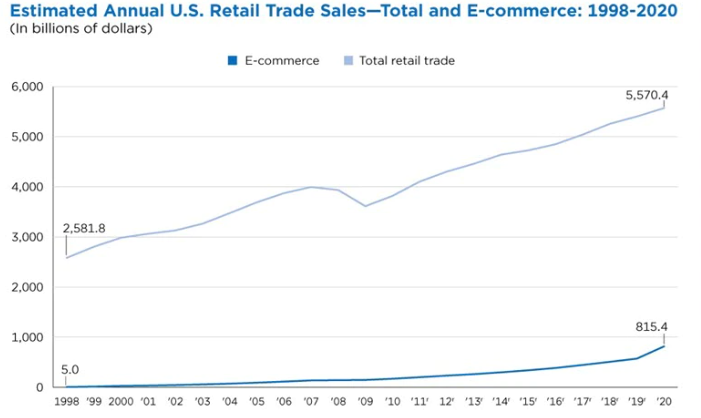An Introduction to Product Information Management (PIM) Software
By Rajesh Sikka, OCI Business Analyst
June 2022
This article illustrates a product’s journey from product inception to when it's available to the customer and provides product managers with an understanding of how product information management (PIM) benefits organizations and ensures that customers have a pleasant experience when buying products on their websites.
Products, their types, and customers' buying experiences over the years
Products are a central part of everybody's life. Organizations manufacture them for customers to fulfill their needs.
Products are of three types:
- Physical. Car, Clothing
- Virtual. Education, Software
- Hybrid. Apple Watch

Figure 1. Evolution of customer buying experience
Figure 1 depicts how the customer’s product-buying experience has evolved. In the beginning, the customer's only option was to go to a physical store to buy a product (single channel). As years progressed, customers could buy products from catalogs, physical stores, and websites. The customer's data resided on multiple organization systems (multi and omni channel).
Today, the customer occupies the central piece of any organization’s business strategy. The customer's data resides on multiple systems that talk to one another (unified commerce). This enables the customer to have a valuable experience when viewing and buying products on an organization’s website. In addition, it helps the organization make sound business decisions that are in line with the company’s strategic goals and also benefit the customer.
Product data journey
The illustration below shows how a new product moves between departments from inception to commercialization. It also displays the activities performed by department personnel to make sure that the product has a successful launch.

Figure 2. Product journey
- The brand teams float the product idea.
- The research and development team does specific research and analysis on the product.
- The planning team works on forecasting product demand and the product roadmap.
- The finance team finalizes the product cost and accordingly comes upon the product price.
- The supply-chain team is responsible for production planning, manufacturing, packaging, and ensuring enough stock is available in the warehouse based on market demand.
- The creative and marketing teams work toward enriching the product data required for online sales channels.
- The legal team works to seek the necessary approvals from state and federal agencies.
- The master data team, a branch of information technology (IT), enters the product attributes and stock-keeping unit (SKU) information into the enterprise resource planning (ERP) system for financials, analytics, inventory planning, and historical data purposes.
- Once all the product information is available, the e-commerce team syndicates it to e-commerce and retailer websites.
The product is now available to the customer for use.
PIM its categories, its role, and its benefits
PIM is software for managing and enriching product data with associated digital assets.
The marketing team should ensure that the data spans three product information categories when enhancing product data. They are as follows:
- Emotional Information. Detailed, vivid descriptions and images of the product targeting the customer
- Technical Information. Product attributes like color, size, weight, length, width, height, and material composition
- Usage Information. Instructions for the customer on how to use the product
All three are necessary for product data to be trustworthy, relevant, and complete. Organizations use this data to sell products through various distribution channels.
PIM benefits organizations with a wide array of products whose features are frequently changing and whose sales channels are multiplying worldwide.
PIM serves as a central hub for all the organization's product data and is the sole source of truth concerning product data. PIM shares electronic data fields with trading partners and distributes data to e-commerce websites; marketplaces like Amazon, Google Shopping, and Shopify; and social media sites like Facebook and Instagram. It also supports multiple geographic locations, multilingual data, and product information maintenance and modification within a centralized catalog.
The illustration below shows the organization system architecture where PIM is at the center, receiving the product data from various sources, enriching it, and finally syndicating the data to internal and external entities listed under touchpoints.

Figure 3. Organization system architecture
Factors required by an organization for a successful PIM implementation
Leadership Support
The PIM implementation should be part of the organization’s strategic initiative. The leadership team should remember that PIM will not immediately resolve all product data issues. Instead, it should expect PIM to be a powerful tool that will grow its business eventually.
Getting buy-in from stakeholders
Using the product data, the organization's teams should work to implement PIM successfully. They should collaborate to identify the data sources (i.e., ERP, spreadsheets, CRM) for the PIM. In addition, they should make sure that the product taxonomy definition is on the same lines as the brand strategy.
Getting Data Ready for PIM Migration
Correct catalog classification is critical to ensure that migration is successful to the PIM system. Before data migration to PIM begins, the team should define catalog taxonomy (i.e., organizing the data into layers) aligning with brand strategy. In addition, the team should always consider the following steps:
- Identify the types of data accepted by the PIM. For example, what attribute types are allowed?
- Each product should possess a unique SKU. Most PIMs use this unique identifier.
- Determine the attributes (i.e., data points about your product) and variants for the product. Most PIMs have no limit to the number of attributes and variants a product may have. For example, when a retail store sells a shirt, the shirt size is the attribute while the color is the variant.
- Determine the product categories and sub-categories that identify the organization’s product range.
- The technical team should refer to the PIM’s technical manual when defining sub-categories. For example, Plytix has a limit of six when doing a CSV data import.
-
Products, attributes, assets, and organizational items like categories should possess standardized naming conventions to help SEO search when users search for products.
- Identify the digital assets (images, videos, and pdfs) for each product. Most PIMs associate these assets as attributes of the products. Widen Collective PIM treats them separately because it includes a DAM digital asset management (DAM) component.
Once product classification is complete, the next step is to determine how to import the data to the PIM. This can be done in one of four ways:
- API connection. Establishing a link to an external data platform, such as an ERP.
- Manual creation. Adding product data into the PIM platform via manual data entry.
- Manual CSV import. Uploading a CSV file to bulk import products.
- Scheduled import feeds. Setting up a scheduled import job that runs and updates the PIM.
PIM Integration with eCommerce Sites
Once product data gets migrated to the PIM, the next task for the organization is to integrate it with e-commerce sites like Amazon, Google Marketplace, and eBay. While the PIM provides product data details, an API connection between the e-commerce website and the ERP platform manages price, stock levels, and order status information.
The organization should avoid manual publishing (i.e., by logging into the individual websites) of product data at all costs. This process can be prone to errors, resulting in inaccurate or obsolete product data.
The organization's objective should be to integrate the PIM into all e-commerce websites so that product data remains the same across all channels.
CRM-PIM Integration
The organization's marketing or sales team probably uses a customer relationship management (CRM) platform to track and maintain customers data. This software stores all customer interactions with the organization's products at different touchpoints on the e-commerce websites. For example, it contains the customer’s behavior and statistics regarding product purchases, time spent on the organization’s website, and reasons for choosing not to buy the product. The organization can quickly shift the product strategy based on customer analytics, thus making sure customers regularly visit the website, stay longer, and buy products consistently.
PIM Roles and Responsibilities
The initial PIM configuration setup is the vendor's responsibility. The vendor works with IT to establish PIM configuration for the organization.
Once the PIM is in place, leadership should decide which team should be the owner of the PIM for software enhancements and issues. In most organizations, it is the IT team that is responsible. IT integrates the PIM to data sources and sets up the jobs to push data to the designated sales channels. In addition, they provide the PIM security for the business to access product data and enrich it, per the sales distribution site's requirements.
Choosing between an open source PIM vs. a SAAS PIM
Organizations can decide between an open source PIM and software-as-a-service (SaaS) PIM. Below are the pros and cons.
| Open-Source PIM | SaaS PIM | |
|---|---|---|
| Customization | Yes; code-level customization | Yes; granularity dependent on vendor |
| Database Access / Management | Yes | No |
| Infrastructure Configuration | Yes | No |
| Infrastructure Maintenance | Yes | No |
| Setup/Configuration Difficulty | Medium/High | Low |
| Technical Expertise | High | Low/Medium |
| Features | Community dependent | Platform dependent |
| Integrations | Yes | Yes; granularity dependent on vendor |
| Licensing/Subscription Fees | None | Yes |
| Security/Compliance | Unmanaged; user responsibility | Dedicated; vendor's responsibility |
| Support | Community support | Dedicated support |
The organization’s leadership should keep in mind that even though an open source PIM is a free solution, it is likely to require an expert to do the complex configurations necessary to meet the organization's requirements. In addition, the code available to the public can change without the organization's knowledge, which can result in delays in PIM implementation.
Suppose the organization selects a licensed version (a PIM provided by a vendor). This will result in a faster turnaround, require fewer resources, and have the necessary support of the vendor during implementation.
Top PIM software vendors
| Name | Best For | Website | Open Source |
|---|---|---|---|
| Widen Collective | PIM and DAM unification | https://www.widen.com/ | No |
| PIM works | Multichannel syndication | https://www.pimworks.io/ | No |
| Informatica | Role-based user interface | https://www.informatica.com/ca/ | No |
| Feedonomics | Remarketing toolkit | https://feedonomics.com/ | No |
| Productsup | Publishing product data to websites | https://www.productsup.com/ | No |
| Agility Multichannel | Print catalog production | https://www.agilitymultichannel.com/ | No |
| Pimcore | Open source PIM software | https://pimcore.com/en | Yes |
| Syndigo | E-commerce analytics | https://syndigo.com/ | No |
| InRiver | Reseller self-service portal | https://www.inriver.com/ | No |
| Akeneo | Built-in task management | https://www.akeneo.com/ | Yes |
Further details can be found in this article published by E-commerce Manager illustrating the top 10 PIM software in 2022.
Role of artificial intelligence and machine learning in PIM solutions
Artificial intelligence (AI) and machine learning (ML) work together in software applications and user-driven processes. For organizations to provide their customers with a modern product experience, it has become necessary that product data be exposed to AI-enabled applications, ensuring an error-free process during product data onboarding in a PIM system. The top use cases for AI in PIM are as follows:
Automated keyword extraction
AI can read and extract relevant keywords from product source data and assign them automatically to PIM schema for the associated products. In addition, during the extraction process, synonyms, antonyms, hyponyms, and other linguistic features are identified for use in automated text generation.
Automated text generation
Based on preset phrasing patterns, AI can use grammatical laws and idioms to independently create product and item descriptions based on the information contained and managed in the PIM system.
Computer Vision
Computer vision can facilitate product enrichment. Apart from just interpreting information from images and videos, it can assign additional attributes to a product with other programming logic.
Natural Language Processing
PIM solutions can use natural language processing (NLP) to participate in growing trends like voice search and voice command with structured, widely distributed, and constantly up-to-date product data.
Machine Learning
ML is used to train PIM applications to reduce errors and improve accuracy. Computer vision, NLP, and ML in tandem provide organizations with better product analysis and insights into optimizing product data.
Which industry will drive the PIM market in the future?
The retail and e-commerce industries will drive the PIM market in the coming years because of the growing interest in enhancing customer experience and adopting the industries' AI and retail analytics tools.
The Asian Pacific region is currently experiencing the fastest growth in this industry. In the United States, according to the 2020 Annual Retail Trade Survey (ARTS) Release, "e-commerce sales increased by $244.2 billion or 43% in 2020, the first year of the pandemic, rising from $571.2 billion in 2019 to $815.4 billion in 2020."
The graph below shows the details.

Figure 4. Estimated retail trade sales [Source: 2020 Annual Retail Trade Survey (ARTS)]
Concluding thoughts
“Markets and Markets" expects the global PIM market to grow from 9 billion USD to 16 billion USD by 2025 at 12.2%. To meet the growing demand, organizations will need to leverage the PIM effectively to keep up with consumer behavioral change. The organization's IT department will have to assess which PIM software will help fulfill the company's needs, and organizations will have to prepare data according to the PIM software vendor's specifications. If these guidelines are not followed, a PIM can become a bottleneck for the company. Finally, and most importantly, retailers must make sure that information about their products is updated regularly, pricing is competitive, and stock is readily available for consumers when they're shopping for products.
Software Engineering Tech Trends (SETT) is a regular publication featuring emerging trends in software engineering.
